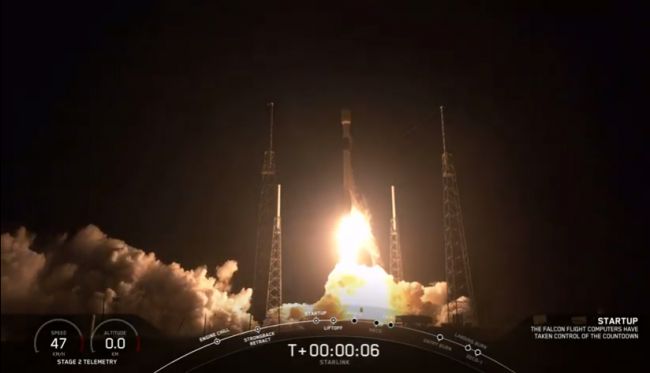SpaceX Launches 60 Starlink Satellites on Thrice-Flown Rocket, Sticks Landing
Following the successful launch, the rocket's first stage gently touched down on a floating platform at sea, marking the company's 40th booster recovery. It was the third flight for this particular booster, marking just the second time SpaceX has flown a Falcon 9 first stage more than twice.
The third time was a charm for SpaceX as the Falcon 9 lifted off at 10:30 p.m. EDT (0230 GMT on May 24) from Space Launch Complex 40 at Florida's Cape Canaveral Air Force Station here, following several delays: first a 24-hour delay due to high upper-level winds on May 15, and then a weeklong delay so SpaceX could give the onboard satellites a software software upgrade.
Tucked inside the rocket's nose cone were 60 satellites — the first batch of SpaceX's Starlink megaconstellation, which the company hopes will help provide affordable internet coverage to the world.
Related: Launch Photos for SpaceX's 1st Starlink Internet Satellite Flight!

Prior to the first launch attempt, SpaceX CEO Elon Musk tweeted a picture of the fleet cocooned in the Falcon 9's payload fairing, waiting for launch. The tightly packed satellites, which resemble a giant deck of cards, filled nearly every inch of the Falcon 9's payload fairing.
This arrangement was a stark contrast to another photo Musk shared, which featured his cherry-red Tesla Roadster barely taking up any space inside its fairing, which launched on the Falcon Heavy rocket's maiden voyage in February 2018.
Each of the Starlink satellites weighs 500 lbs. (227 kg). The 60-spacecraft haul is the heaviest payload that a Falcon 9 has yet hoisted to orbit, SpaceX representatives have said.
Sign up for the Live Science daily newsletter now
Get the world’s most fascinating discoveries delivered straight to your inbox.
The satellites rode into space atop a veteran Falcon 9 first stage. Dubbed B1049.3, an internal designator by SpaceX, the booster has now made three trips to space and back, having previously lofted the Telstar 18 VANTAGE and Iridium 8 missions to orbit.
A huge constellation
In total, SpaceX plans to launch nearly 12,000 of these satellites, which will park themselves in low-Earth orbit and beam internet coverage to the world below. There will be two Starlink flocks: one constellation of 4,409 satellites and a second constellation of 7,518 satellites, according to an agreement with the Federal Communications Commission (FCC). The second, larger constellation will fly at a slightly lower altitude, but together both will provide affordable coverage to every part of the globe, SpaceX representatives have said.
One caveat: the FCC approvals require the company to launch half of the planned satellites within the next six years. SpaceX first launched Starlink craft in 2018, lofting two test satellites, dubbed TinTin A and TinTin B, in February of that year. Their mission seemingly went well, though SpaceX kept the pair in a lower orbit than first planned. Based on data obtained from that initial test mission, SpaceX requested that part of its fleet be allowed to operate at lower altitudes, and the FCC agreed.
Now the company has launched operational versions of the Starlink satellites, but these first 60 spacecraft are still a test version of sorts. Varying slightly from the thousands the company plans to mass produce, this first group of 60 lacks some of the design features the final constellation will require. For instance, these satellites will not be able to communicate with each other directly, but they will be able to communicate with the ground and maneuver themselves around.
This batch will also be used to test how best to safely deploy Starlink satellites into orbit. These 60 satellites were flat-packed inside the fairing, meaning there was no dispenser for deploying them.
During a prelaunch teleconference with reporters on May 15, Musk detailed how the satellites would be deposited. Instead of using spring mechanisms to deploy each satellite, SpaceX engineers opted to use the satellites' own inertia.
The Falcon 9 upper stage rotated, and the Starlink satellites deployed like cards spreading on a table. All 60 floated freely into orbit an hour after launch, and all had come online by about an hour after that, Musk said via Twitter tonight.
Related: SpaceX Launches 1st Test Satellites for Starlink Internet Constellation
Test run
These first five dozen Starlink satellites incorporate a great deal of advanced engineering, Musk said. But he doesn't expect the spacecraft to perform perfectly.
"Much will likely go wrong," Musk said via Twitter recently. He added that these 60 satellites are just the beginning; another six launches of 60 satellites each are needed before Starlink can begin to provide minor internet coverage, and another 12 launches for moderate coverage.
"This will not only provide internet access to areas that don't have it, but provide competitive access to areas that already have connectivity," Musk said in the May 15 telecon.
Currently, we rely on wireless cell towers or cables routed into our homes and offices to provide internet access. This means that rural, remote areas around the world are often without access. Many other options for satellite-based internet exist, but are very expensive and offer very slow connecting rates. (Remember dial-up?)
That's because the satellites that provide this service are too far away. SpaceX wants to change that, and it's not alone. Several companies (including OneWeb, TeleSat, and now Amazon) want to provide internet to the masses by deploying a network of small satellites in low-Earth orbit, hovering much closer to the Earth than the satellites providing internet services currently.
OneWeb launched its first six satellites in February. But with 60 satellites now in orbit, SpaceX could be the first to provide extensive coverage.
- See the Evolution of SpaceX's Rockets in Pictures
- In Photos: SpaceX's 1st Falcon Heavy Rocket Test Launch Success!
- Elon Musk: Private Space Entrepreneur
Follow Amy Thompson on Twitter @astrogingersnap. Follow us on Twitter@Spacedotcom or Facebook.










